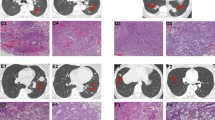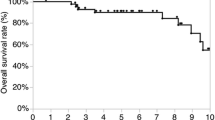Abstract
Purpose
To investigate the influence of multiple primary malignancies (MPMs) on the prognosis of patients with completely resected non-small cell lung cancer (NSCLC).
Methods
The subjects of this retrospective study were 521 patients who underwent complete curative pulmonary resection for NSCLC. Patients were divided into two groups: those with and those without MPMs.
Results
The 521 NSCLC patients included 184 patients (35.3%) with MPMs and 337 patients without MPMs. The overall 5-year survival rates for patients with vs those without MPMs were 66.1 and 75.6%, respectively (p = 0.0061). According to multivariate analysis, MPMs, age, gender, pathological stage, and interstitial pneumonia were independent predictors of prognosis. The 47 patients with synchronous MPMs and the 82 patients with metachronous MPMs found within the last 5 years had significantly poorer prognoses than patients without MPMs (p = 0.0048 and p = 0.0051, respectively). However, the prognoses of the 55 patients with metachronous MPMs that had been present for over 5 years did not differ from those of the patients without MPMs.
Conclusions
NSCLC patients with synchronous MPMs or metachronous MPMs diagnosed within the last 5 years had poor prognoses. Decisions about the best therapeutic strategies require comprehensive consideration of the organ location, malignant potential, recurrence, and prognosis of the MPMs. In contrast, decisions about the best therapeutic strategies for NSCLC patients with metachronous MPMs present for over 5 years should be based solely on the NSCLC.



Similar content being viewed by others
References
Irimie A, Achimas-Cadariu P, Burz C, Puscas E. Multiple primary malignancies–epidemiological analysis at a single tertiary institution. J Gastrointest Liver Dis. 2010;19:69–73.
Demandante CG, Troyer DA, Miles TP. Multiple primary malignant neoplasms: case report and a comprehensive review of the literature. Am J Clin Oncol. 2003;26:79–83.
Kim SW, Kong KA, Kim DY, Ryu YJ, Lee JH, Chang JH. Multiple primary cancers involving lung cancer at a single tertiary hospital: Clinical features and prognosis. Thorac Cancer. 2015;6:159–65.
Warren S, Gates O. Multiple primary malignant tumors: a survey of the literature and statistical study. Am J Cancer. 1932;16:1358–414.
Moertel CG, Dockerty MB, Baggenstoss AH. Multiple primary malignant neoplasms. I. Introduction and presentation of data. Cancer. 1961;14:221–30.
Liu YY, Chen YM, Yen SH, Tsai CM, Perng RP. Multiple primary malignancies involving lung cancer-clinical characteristics and prognosis. Lung Cancer. 2002;35:189–94.
Aguiló R, Macià F, Porta M, Casamitjana M, Minguella J, Novoa AM. Multiple independent primary cancers do not adversely affect survival of the lung cancer patient. Eur J Cardiothorac Surg. 2008;34:1075–80.
Li F, Zhong WZ, Niu FY, Zhao N, Yang JJ, Yan HH, et al. Multiple primary malignancies involving lung cancer. BMC Cancer. 2015;15:696.
Fujita S, Masago K, Takeshita J, Togashi Y, Hata A, Kaji R, et al. Multiple primary malignancies in patients with non-small cell lung cancer. Intern Med. 2015;54:325–31.
Lorigan P, Radford J, Howell A, Thatcher N. Lung cancer after treatment for Hodgkin’s lymphoma: a systematic review. Lancet Oncol. 2005;6:773–9.
Kabat GC. Previous cancer and radiotherapy as risk factors for lung cancer in lifetime nonsmokers. Cancer Causes Control. 1993;4:489–95.
Wynder EL, Mushinski MH, Spivak JC. Tobacco and alcohol consumption in relation to the development of multiple primary cancers. Cancer. 1977;40:1872–8.
Hsieh WC, Chen YM, Perng RP. The temporal relationship of lung cancer and upper aerodigestive cancer. Jpn J Clin Oncol. 1997;27:63–6.
Schwartz LH, Ozsahin M, Zhang GN, Touboul E, De Vataire F, Andolenko P, et al. Synchronous and metachronous head and neck carcinomas. Cancer. 1994;74:1933–8.
Koppe MJ, Zoetmulder FAN, van Zandwijk N, Hart AAM, Baas P, Rutgers EJTk. The prognostic significance of a previous malignancy in operable non-small cell lung cancer. Lung Cancer. 2001;32:47–53.
Duchateau CS, Stokkel M. Second primary tumors involving non-small cell lung cancer. Prevalence and its influence on survival. Chest. 2005;127:1152–8.
Hofmann HS, Neef H, Schmidt P. Primary lung cancer and extrapulmonary malignancy. Eur J Cardiothorac Surg. 2007;32:653–8.
Utsumi T, Fujii Y, Takeda S, Minami M, Yoon HE, Okumura M, et al. Clinical study on lung cancer as second primary cancer. Surg Today. 1998;28:487–91.
Ishida T, Saitoh G, Maruyama R, Fukuyama Y, Hamatake M, Inoue T, et al. Survival following resection for lung cancer as a second primary cancer. Int Surg. 1995;80:227–30.
Kurishima K, Satoh H, Homma S, Kagohashi K, Ishikawa H, Ohtsuka M, et al. Multiple primary malignancies in patients with lung cancer. Radiol Oncol. 2005;39:49–53.
Dequanter D, Shahla M, Lardinois I, Gilbert O, Hanquet O, Tragas G, et al. Second primary lung malignancy in head and neck cancer patients. Eur Ann Otorhinolaryngol Head Neck Dis. 2011;128:11–3.
Sato T, Watanabe A, Kondo H, Kanzaki M, Okubo K, Yokoi K, et al; Japanese Association for Chest Surgery. Long-term results and predictors of survival after surgical resection of patients with lung cancer and interstitial lung diseases. J Thorac Cardiovasc Surg. 2015;149:64–9. (70.e1-2.)
Author information
Authors and Affiliations
Corresponding author
Ethics declarations
Conflict of interest
We have no conflicts of interest to declare.
Rights and permissions
About this article
Cite this article
Komatsu, H., Izumi, N., Tsukioka, T. et al. Prognosis associated with synchronous or metachronous multiple primary malignancies in patients with completely resected non-small cell lung cancer. Surg Today 49, 343–349 (2019). https://doi.org/10.1007/s00595-018-1738-4
Received:
Accepted:
Published:
Issue Date:
DOI: https://doi.org/10.1007/s00595-018-1738-4




